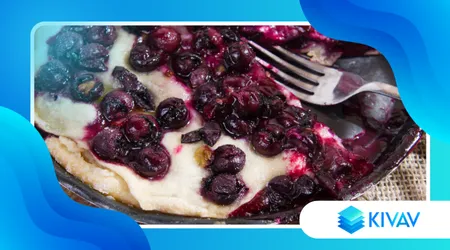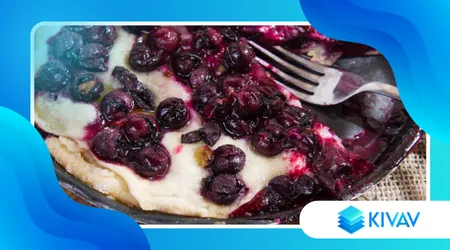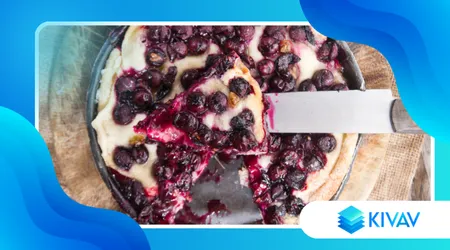Sweet Focaccia with Grapes: A Masterpiece of Taste and Tradition
There sweet focaccia with grapes, a jewel of Italian cuisine, is much more than just enriched bread.
Announcements
It's a sensory journey that combines the softness of leavened dough with the juicy sweetness of grapes, creating a perfect balance between tradition and innovation.
This dish, typical of regions like Tuscany and Veneto, is an example of how simple ingredients can transform into an extraordinary gastronomic experience.
But what makes sweet focaccia with grapes so special?
Is it just a dessert or a versatile bread to enjoy at any time of the day?
Announcements
Sweet Focaccia with Grapes

Sweet focaccia with grapes is not just a food, but a symbol of conviviality.
Making it means immersing yourself in a tradition that dates back centuries, when farmers used late summer grapes to create a sweet bread that celebrated the harvest.
Today, this recipe has evolved, but retains its rustic heart.
Furthermore, its versatility makes it suitable for many occasions: from breakfast to dessert, up to an accompaniment for mature cheeses.
For this reason, learning to make sweet focaccia with grapes is not just a matter of cooking, but a way to connect with Italian culture.
We will begin by analyzing the history and cultural importance of this dish, and then move on to preparation techniques, regional variations, and practical advice for achieving an impeccable result.
We'll conclude with a FAQ section to answer the most common questions.
Get ready to discover why sweet focaccia with grapes deserves a place of honor in your kitchen.
The History and Cultural Significance of Sweet Focaccia with Grapes

Sweet focaccia with grapes has its roots in Italian peasant traditions, especially during the grape harvest season.
In regions like Tuscany, where grapes are a symbol of abundance, this sweet bread was prepared to celebrate the end of summer.
The choice of grapes, often local varieties such as Sangiovese or Canaiolo, was not accidental: these grapes, rich in juice and natural sugars, gave the bread a unique flavor.
++ Pizza by the slice: how to prepare it
Furthermore, sweet focaccia with grapes was an ingenious way to use up excess grapes, turning them into a dish that could be stored for days.
Over time, the recipe spread to other regions, adapting to local tastes.
For example, in Veneto, sweet focaccia with grapes is often enriched with a pinch of rosemary, which adds a surprising aromatic note.
This evolution demonstrates the ability of Italian cuisine to reinvent itself without losing its essence.
Today, sweet focaccia with grapes is enjoyed not only in homes but also in Michelin-starred restaurants, where creative chefs offer it in bold combinations, such as with gorgonzola ice cream or mascarpone cream.
Isn't it amazing how such a simple dish can span the centuries and remain relevant?
An interesting fact: according to research conducted by the Italian Sommelier Association in 2023, 65% of Italian consumers prefer to pair sweet focaccia with grapes with sweet wines such as Vin Santo or Moscato, highlighting its versatility as a dessert or accompaniment.
This statistic highlights the importance of choosing quality ingredients, such as fresh, ripe grapes, to enhance the flavor of the dish.
Sweet focaccia with grapes, therefore, is not just a food, but a bridge between past and present, an invitation to celebrate seasonality and creativity in the kitchen.
Preparation Techniques: How to Make the Perfect Sweet Grape Focaccia

Prepare a sweet focaccia with grapes It requires attention to detail, but it is not a complex undertaking.
The key lies in the choice of ingredients and in managing the leavening.
The dough, made from flour, water, yeast, sugar, and olive oil, should be soft and slightly sticky.
To obtain a soft texture, it is essential to knead for a long time, at least 10 minutes, to develop the gluten.
Furthermore, the addition of high-quality extra virgin olive oil not only enhances the flavor, but contributes to a crispy crust that contrasts with the soft interior.
A common mistake is overlooking the quality of the grapes. The ideal varieties are black grapes, such as strawberry grapes or Sangiovese, because their intense flavor pairs perfectly with the sweetness of the dough.
However, it is important to wash the grapes thoroughly and dry them well to prevent them from releasing too much water during cooking, compromising the consistency.
A trick?
Sprinkle a little sugar over the grapes before baking: this creates a light caramelization that makes every bite unforgettable.
To make it easier for you, here is a table with the basic proportions for a perfect dough:
| Ingredient | Amount | Notes |
|---|---|---|
| 00 flour | 500 g | Prefer medium strength flour (W 220-260) for good leavening. |
| Waterfall | 300 ml | Warm, to activate the yeast. |
| Fresh brewer's yeast | 15 g | Or 5 g of dry yeast. |
| Sugar | 80 g | Adds sweetness and promotes browning. |
| Extra virgin olive oil | 50 ml | Choose an oil with a fruity flavor. |
| Black grapes | 400 g | Washed and dried, preferably without seeds. |
By following these instructions, your sweet focaccia with grapes will be a guaranteed success.
But don't stop there: experiment with adding orange zest or a pinch of cinnamon for a personal touch.
Regional Variants and Creative Combinations
The beauty of sweet focaccia with grapes lies in its ability to adapt to different regional traditions.
In Tuscany, for example, “schiacciata con l'uva” is an icon of the harvest, often prepared with Sangiovese grapes and served with a glass of Chianti.
On the contrary, in Liguria, a thinner dough is preferred, enriched with pine nuts and rosemary, which creates a contrast between sweet and salty.
These variations demonstrate how a simple dish can take on different nuances, while maintaining its identity.
An effective analogy to describe sweet focaccia with grapes is that of an impressionist painting: each region adds a touch of color, a unique detail, but the whole remains harmonious and immediately recognizable.
Just as Monet used different brushstrokes to capture the light, each version of this bread reflects the territory from which it comes.
This makes sweet focaccia with grapes not just a dish, but a narrative of Italian culture.
To explore further, here are two original examples of sweet focaccia with grapes that you can try:
- Sweet focaccia with grapes and walnutsAdd 100g of coarsely chopped walnuts to the batter and drizzle the top with honey before baking. This creates an extra crunch and rich flavor, perfect for a fall dessert.
- Sweet focaccia with grapes and lavenderInfuse the mixture with a pinch of dried lavender flowers (no more than a teaspoon). The floral note pairs beautifully with the strawberry grape, creating a unique sensory experience.
These examples show how sweet focaccia with grapes can be personalized without losing its traditional character.
Try serving it with blue cheese or vanilla ice cream for a modern pairing that will surprise your guests.
Practical Advice and Mistakes to Avoid
To obtain a perfect sweet focaccia with grapes, it is essential to pay attention to some details.
First of all, the leavening: a well-leavened dough is the basis of a soft focaccia.
Let the dough rest for at least 8 hours in a warm, humid place, covered with a cloth.
Also, avoid overloading the surface with too many grapes: too many can make the focaccia moist and heavy.
A good balance is to distribute the grapes evenly, leaving space between each one.
Another crucial aspect is the oven temperature.
Bake at 200°C for about 25-30 minutes, but check that the surface is golden and crispy.
If the oven is too hot, the focaccia risks overcooking on the surface and remaining raw on the inside.
Finally, let the focaccia cool for at least 10 minutes before cutting it: this allows the grape juices to stabilize, preventing the bread from falling apart.
Here is a table with the most common mistakes and how to avoid them:
| Mistake | Cause | Solution |
|---|---|---|
| Dough too thick | Too much flour or too little water | Measure the ingredients carefully and add water gradually. |
| Moist focaccia | Excess grapes or undried grapes | Dry the grapes well and distribute them evenly. |
| Burnt surface | Oven temperature too high | Cook at 200°C and check after 20 minutes. |
| Not very intense flavour | Low-quality or under-ripe grapes | Choose ripe black grapes, such as Sangiovese or strawberry grapes. |
By following these tips, your sweet focaccia with grapes will be not only delicious, but also visually appealing, ready to conquer anyone's palate.
Frequent questions about Sweet Focaccia with Grapes
| Request | Answer |
|---|---|
| Can I use white grapes for focaccia? | Yes, but black grapes like Sangiovese or strawberry grapes offer a more intense flavor and an attractive color. |
| How long does sweet focaccia with grapes keep? | Store in an airtight container at room temperature for 2-3 days. For extra freshness, reheat slightly before serving. |
| Can I freeze focaccia? | Absolutely. Wrap it in plastic wrap and freeze it for up to 3 months. Defrost it at room temperature and reheat it in the oven. |
| Is it possible to make a gluten-free version? | Yes, using gluten-free flour and a suitable yeast. However, the consistency may be slightly different. |
| Which wine pairs best? | A Vin Santo or Moscato are ideal, but even a light Prosecco works well for a fresh contrast. |
These answers address the most common questions, making sweet grape focaccia accessible even to beginners.
Conclusion: Why Sweet Focaccia with Grapes is a Must
There sweet focaccia with grapes It's much more than just sweet bread: it's an experience that combines tradition, creativity, and flavor.
Its history rooted in peasant culture, its regional variations, and its versatility make it a dish that deserves to be rediscovered and celebrated.
Whether you're an expert cook or a beginner, making a sweet focaccia with grapes will allow you to bring a piece of authentic Italy to the table.
With simple ingredients and a little patience, you can create a masterpiece that will amaze your guests.
Experiment with the suggested variations, such as the one with walnuts or lavender, and don't be afraid to customize it.
After all, isn't that the beauty of Italian cuisine?
The ability to transform humble ingredients into extraordinary dishes?
Try making your own sweet focaccia with grapes and discover the pleasure of a flavor that tells a story.
